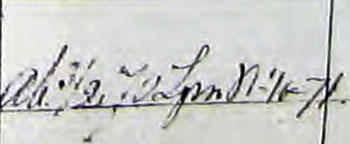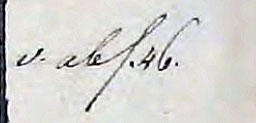

Copyright © Hans Högman 2020-07-16


Absolution of Women after
Childbirth - Churching of women
A woman was considered ritually impure after
childbirth. The period of impurity lasted for 6 weeks
after giving birth. Thereafter the woman was
resumed into the church community via a church
rite. This rite was called “kyrktagning” or absolution
in Sweden. In English it is known as Churching of
Women.
Absolution is a traditional theological term for the
forgiveness experienced in the Sacrament of
Penance.
Absolution/Churching
The rite of resumption into religious and social life
after childbirth was traditionally considered a
ceremonial purification rite even if the ceremony
itself contained no elements of ritual purification.
The 6 weeks of impurity after childbirth is recalled
from directions in the Old Testament regarding 40
days of impurity (3 Mos. 12).
In Christian tradition the Churching of Women is
the ceremony wherein a blessing is given to
mothers after recovery from childbirth. The
ceremony includes thanksgiving for the woman's
survival of childbirth.
Recent mothers were not allowed to work outdoors
or to attend church service between childbirth and
churching. In a way the period of impurity was a
confinement of the women. This was a problem for
poor families where the women couldn't afford to
wait 6 weeks to regain work. In 1866 the period of
impurity was reduced to 4 weeks.
A notice of churching had to be filed to the parish
registrar's office in advance. The notice was to be
delivered by the woman's husband. Churching were
normally officiated just before the regular Sunday
service.
In the beginning churching was conducted at the
church gateway. It was a sense of shame to
undergo churching at the gateway since this was
also the place where the impenitent and
condemned were chained to atone for their sins.
Besides, it was cold and draughty by the gateway
which wasn't healthy for a woman who recently
given birth to a child.
The churching rite was therefore later in time
moved into the church and was conducted by the
altar. If there were several women to undergo
churching it was the more prominent women that
received churching first, women of small means
had to wait in line.
During the rite the woman had to bend down on
her knees on a special absolution stool. The
reverend then said a special thanksgiving prayer,
took the woman by her hand and gave her a
blessing.
Before the 1870's the women had to pay a special
fee for churching ceremony.
Unmarried mothers weren't allowed churching.
Instead they had to confess their sins (skriftades) in a
rite. This rite wasn't normally performed at Sunday
Service but during a weekday. The reverend didn't
take these women by their hands either. These
women also had to bend down on their knees
during the rite but not on the absolution stool.
Instead they had to kneel down onto the cold stone
floor in the church or onto an undressed stool.
At first churching of women after childbirth was a
Purification rite. However, after the Reformation in
the 1500's churching of women became a
ceremony wherein a blessing was given to mothers
after recovery from childbirth. The ceremony
includes thanksgiving for the woman's survival of
childbirth. However, the perception of the
ceremony as a purification ritual existed for a very
long time among country people.
In the 1870's and 1880's churching of women
began to abate. However, it was still in practice on
the Swedish West coast in the 1940's and 1950's.
The Church Records
You will normally find notes about churching of
women in the Swedish birth books (födelseböcker)
but sometimes also in the in the household
examination rolls (husförhörslängder) or the
moving records (flyttlängder). You will then see
notations such as "Abs." or just "Ab." sometimes
followed by a date. "Abs." or "Ab" is short for
"absolution".
Extract from the household examination roll
(husförhörslängden) Strängsered (P) AI:4 (1838-1847)
bild 6 / sid 113 (AID: v44451.b6.s113, NAD:
SE/GLA/13507).
Here we have the notation "abs. 46", i.e. absolution
1846.

Churching, Absolution
- Kyrktagning, Sweden
Extract from the household examination roll
(husförhörslängden) Gustav Adolf AI:7 (1867-1875)
bild 138 / sid 133 (AID: v20046.b138.s133, NAD:
SE/VALA/03255).
Here we have the notation "ab. 3/2 70", i.e.
absolution on February 3, 1870 (3/2 1870). To the
right
there is a banns notation (lysning).

Christening
A child was to be baptized within 8 days after
birth. It was a church rule (common law). This
means that the mother wasn't able to be present at
the Christening of her child since she then still was
impure and not yet churched. Children was always
baptized in church unless it was a baptism in an
emergency.
For some reason it wasn't suitable for the father
either to be present at the Christening ceremony.
Instead the child was carried by one of the
godparents during the baptism ceremony. The
godparents/sponsors were morally responsible for
the child's wellbeing if something happened to the
parents. Normally there was a close relative among
the godparents. It could be an older brother/sister,
siblings to the child's parents or even the
grandparents.
It was common that the first born child was carried
by one of the grandmothers at the Christening
ceremony. If they weren’t alive it could be an aunt.
In 1864 the regulation regarding when a child had to
be baptized was changed. Now the time period after
birth when a child had to be baptized was extended
to 6 weeks. So, a child, from 1864, had be baptized
within 6 weeks as opposite of the former 8 days. So,
after 1864 it became common to have the churching
and the baptism at the same church service.
Thereby the mother could be present at the
christening of her child. The churching rite took
place in seclusion and after the rite the mother
could join her family and the guests for the
Christening ceremony.
Christian Names - Traditions
The Christian name given to a first born child was
normally the Christian name of one the
grandparents. It is difficult to say how rooted this
naming practice was. The following was however not
uncommon: the first son was called after his
paternal grandfather, the second son after his
maternal grandfather, while the first daughter was
named after her maternal grandmother, the second
after her paternal grandmother. There are however
numerous examples of other factors coming into
play and it is not at all uncommon to see names that
are neither in the immediate family nor among the
sponsors (godparents). Very common – not to say
mandatory – was naming children after a sibling
who had died.
Source References
•
The Swedish National Encyclopaedia, NE
•
Demografiska databasen, Umeå universitet
•
Släktforskning för alla, Börje Furtenbach, 1986.
•
Namn i Sverige, etnolog Ingela Martenius















